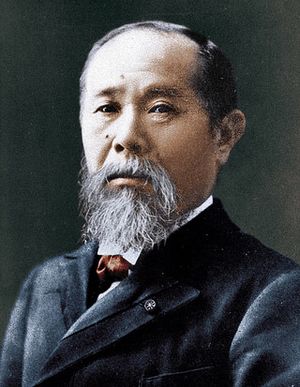Ito Hirobumi facts for kids
Quick facts for kids
Itō Hirobumi
|
|
|---|---|
| 伊藤博文 | |
 |
|
| Prime Minister of Japan | |
| In office 19 October 1900 – 10 May 1901 |
|
| Monarch | Meiji |
| Preceded by | Yamagata Aritomo |
| Succeeded by | Saionji Kinmochi (Acting) |
| In office 12 January 1898 – 30 June 1898 |
|
| Monarch | Meiji |
| Preceded by | Matsukata Masayoshi |
| Succeeded by | Ōkuma Shigenobu |
| In office 8 August 1892 – 31 August 1896 |
|
| Monarch | Meiji |
| Preceded by | Matsukata Masayoshi |
| Succeeded by | Kuroda Kiyotaka (Acting) |
| In office 22 December 1885 – 30 April 1888 |
|
| Monarch | Meiji |
| Preceded by | Position established |
| Succeeded by | Kuroda Kiyotaka |
| Resident General of Korea | |
| In office 21 December 1905 – 14 June 1909 |
|
| Monarch | Meiji |
| Preceded by | Position established |
| Succeeded by | Sone Arasuke |
| Personal details | |
| Born | 16 October 1841 Tsukari, Japan |
| Died | 26 October 1909 (aged 68) Harbin, China |
| Political party | Independent (Before 1900) Constitutional Association of Political Friendship (1900–1909) |
| Spouse | Itō Umeko |
| Alma mater | University College London |
| Signature |  |
Prince Itō Hirobumi (伊藤 博文 Itō Hirobumi) was a very important Japanese politician. He was born on October 16, 1841, and passed away on October 26, 1909. He is famous for being the first Prime Minister of Japan. He also served as Prime Minister three more times. In his younger days, he was sometimes called Hirofumi, Hakubun, or Shunsuke.
Contents
Early Life and Education
Itō Hirobumi was born in Hagi, Yamaguchi. He was adopted by a Choshu samurai family. In 1863, he became a samurai himself. That same year, he visited England. This trip made him realize that Japan needed to become more modern. He believed Japan should learn from Western countries.
He was one of the Choshu Five. This was a group of students who went to study at University College London. In 1864, he returned to Japan with his friend Inoue Kaoru. They tried to stop the Choshu clan from fighting foreign ships. This fight was about passing through the Straits of Shimonoseki. During this time, he met Ernest Satow, who became a lifelong friend.
Leading Japan into a New Era
After the Meiji Restoration, Itō Hirobumi worked in different government jobs. The Meiji Restoration was a big change in Japan. It brought the Emperor back to power and led to many modern reforms. In 1873, Itō became a full government advisor. After a key leader, Okubo Toshimichi, died in 1878, Itō became the home minister. He soon became a very powerful figure in the government.
By 1881, he was the main leader. He traveled to other countries to study how their governments worked. Based on European ideas, he helped create a new system in Japan. This system included a cabinet and civil service in 1885. This new setup replaced the old "Dajokan" system. With these changes, Itō Hirobumi became Japan's first Prime Minister.
Prime Minister of Japan
Itō Hirobumi served as Prime Minister four times:
- First term: December 22, 1885 to April 30, 1888 (861 days)
- Fifth term: August 8, 1892 to August 31, 1896 (1,485 days)
- Seventh term: January 12, 1898 to June 30, 1898 (170 days)
- Tenth term: October 19, 1900 to May 10, 1901 (204 days)
During his second term as Prime Minister (1892-1896), he supported the First Sino-Japanese War (1894-1895). After the war, he helped negotiate the Treaty of Shimonoseki in March 1895. He also became the first leader of the Seiyukai party. He served as Prime Minister two more times (1898 and 1900-1901). He tried to find a peaceful solution with Russia. However, other politicians who favored military action forced him to leave office. Even after leaving the top job, he remained an important figure in the government.
Role in Korea
In November 1905, after the Russo-Japanese War, Japanese forces moved into Korea. The Korean government had to sign a Protectorate Treaty. This treaty gave Japan a lot of control over Korea. Itō Hirobumi became the first Resident General of Korea in 1906.
In 1907, he made the Korean ruler, King Gojong, step down. King Gojong's son, King Sunjong, became the new ruler. Itō also pushed for the Japanese-Korean Convention in 1907. This agreement gave Japan even more control over Korea's internal affairs.
Itō Hirobumi resigned as Resident-General in 1909. However, he was assassinated in Harbin, Manchuria, by a Korean nationalist named An Jung-geun. His death led to Japan fully taking over Korea in 1910 with the Japan-Korea Annexation Treaty.
A Lasting Legacy
Itō Hirobumi's image was featured on the 1,000 yen note of Japan. He appeared on this banknote from 1963-11-01 until a new series was released in 1984.
Images for kids
Related Pages
See also
 In Spanish: Itō Hirobumi para niños
In Spanish: Itō Hirobumi para niños



